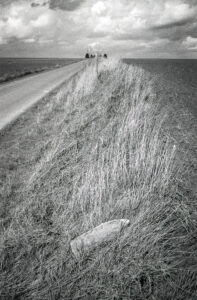Le Pre Fleuri, Corlu, 5th April 1998
A solitary swallow skimmed over the farm as we set out on a circular tour – Delville Wood, Pozieres, Contalmaison and Mametz Wood. Near Combles a line of beaters tramped across the fields hollering and blowing bugles, their sounds and tiny figures consumed by the enormity of the land and sky. Did the infantry look so puny, so exposed, in 1916?
A hare, pale eyed and ears erect, loped across the road in front of us. Beyond a low hedge a lone figure tramped across a field, head down, sack over his shoulder stopping now and then to pick something from the sticky red-brown earth. Unexploded shells lay in ditches; we collected a dozen lead shrapnel balls exposed in the margins of harrowed fields by yesterday’s rain.
Delville Wood: site of bitter, bloody fighting (15 July – 3 September 1916) in the Somme campaign; and a cemetery, the third largest in the region, resting place for 5,523 and home for the South African National Memorial. Dedications sought some purpose, some comfort in the pointless mechanised death: ‘Mizpah’; ‘He died a noble death’; ‘We part to meet again’; ‘O so young yet so brave’; ‘He loved honor more than he feared death’; ‘In short measure life may be perfect’.
Pozieres: a Memorial honours the reversals in March and April 1918 when the Allied Fifth Army was driven back across the former Somme battlefields, and the months that followed before the Advance to Victory. It stands for over 14,000 casualties, who have no known grave and who died on the Somme in spring and summer of that year. Along the road the Tank Corps Memorial near where tanks first went into action with the British Army, a surprise weapon – mechanically unreliable, semi effective against rifles and small arms, easily destroyed by field guns, mortar fire and shrapnel.
Contalmaison: small cemetery, around 300 burials, including Private William Henry Short, VC of the Yorkshire Regiment, died of wounds 7th August 1916, aged 31. Citation: ‘For most conspicuous bravery. … severely wounded in the foot. He was urged to go back, but refused and continued to throw bombs. Later his leg was shattered by a shell, and he was unable to stand, so he lay in the trench adjusting detonators and straightening the pins of bombs for his comrades.’
At Mametz Wood Harry Fellows’s headstone told a happier story. Fellows was born in 1896, the son of a Nottingham coal miner. Both his parents died before the War and he became the breadwinner for a family of four aged eighteen. When the War came he joined up, saying later, ‘not for patriotism, but to escape poverty’. Demobbed in March 1919, Fellows returned to his old job, until he retired in 1962, he died in 1987. His white stone offers lines of hope and joy, ‘Where once there was war, / Now peace reigns supreme, / And the birds sing again in Mametz Wood.’
The day started with a swallow; it ended with skylarks and a rainbow.

